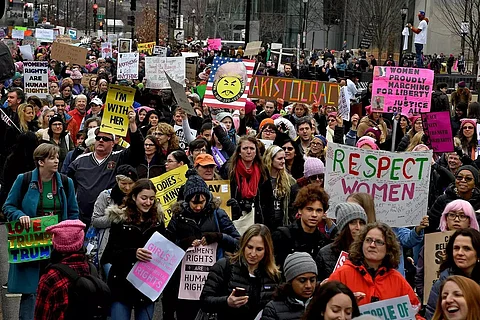
- Home
- Live Blog
- Breaking News
- Top Headlines
- Cities
- NE News
- Sentinel Media
- Sports
- Education
- Jobs

The term Feminism can be used as a
political, cultural, or economic movement focused at giving women equal rights
and legal protection. Political, cultural, and sociological ideas as well as
ideologies that address concerns of gender difference are all part of feminism.
It is a movement that supports women’s rights and interests as well as gender
equality for women. Three waves can be identified in the history of feminism,
according to Maggie Humm and Rebecca Walker. The nineteenth and early
twentieth century saw the first feminist wave; the 1960s and 1970s saw the
second; and the 1990s to the present saw the third. These feminist movements
gave rise to feminist philosophy. It shows up in a number of academic fields,
including feminist history, feminist geography, and feminist literary
criticism. Feminism was theorised differently in India than in the west, as
evidenced by pre-colonial social systems and the role that women played in
them. Political theorisation in the form of nationalism rather than feminism
alone originated from the essentialisation of "Indian culture" by the
colonial powers and the reconstruction of Indian femininity as the pinnacle of
that culture through social reform movements. Notwithstanding these “on-paper”
improvements, there are still many issues that prevent these new rights and
opportunities from being fully accessed. For instance, the Constitution of
India similarly declares that women are a “weaker portion” of society and
require support in order to operate as equals.
The prevalent viewpoints in many facets of Western society, from culture to legislation, have been influenced by feminism. Feminist activists have fought for women’s legal rights (such as the right to vote, the right to own property, and the right to enter into contracts); for women’s right to bodily integrity and autonomy; for the right to an abortion; for the right to a healthy pregnancy; for the protection of women and girls from domestic violence, sexual harassment, and rape; for workplace rights (such as maternity leave and equal pay); and against misogyny and other forms of sexism.
Feminism in India
Feminism’s history in India is viewed as mostly a pragmatic endeavour and essentially non-existent. There hasn’t been much theoretical work on feminism compared to other nations. Feminism was theorised differently in India than in the West, as evidenced by pre-colonial social systems and the role that women played in them. Political theorisation in the form of nationalism rather than feminism alone originated from the essentialisation of “Indian culture” by the colonial powers and the reconstruction of Indian femininity as the pinnacle of that culture through social reform movements. To give feminism in India a unique identity, and to avoid blindly adopting Western ideologies, the Indian feminist scholars and activists define feminism in time and space. Indian women struggle to survive within a variety of restrictive patriarchal family structures, including caste, age, ordinal status, relationship to men through family of origin, marriage, and procreation, as well as patriarchal traits like dowries and siring sons. The diversity of Indian experience demonstrates that there are several patriarchies and various feminisms. As a result, feminism in India is not a single theoretical perspective; rather, it has evolved over time in response to historical and cultural circumstances, degrees of consciousness, perceptions, and behaviours of specific women as well as those of women as a whole. Social reform initiatives pertaining to caste and gender dynamics were sparked by discriminatory behaviours. Men in India started the first wave of feminism around 1850-1915 in order to eradicate the social ills of sati (widow immolation), permit widow remarriage, outlaw child marriage, combat illiteracy, control the legal consent age, and protect property rights. During the period from 1915 to 1947 the fight against colonial rule grew more ferocious. Nationalism rose to become the dominant issue. Claiming Indian superiority became a tactic of cultural revivalism, leading to an essentialising concept of Indian femininity that was unique yet removed from public arena, much like the Victorian womanhood. Gandhi introduced Indian women to the non-violent civil disobedience movement against the British Raj, legitimising and expanding their participation in public activities. He elevated the loving, self-sacrifice, sacrifice, and tolerance roles played by women and created a special place in society for them. Women-only groups like the National Federation of Indian Women (NFIW) and the All-India Women's Conference (AIWC) developed during this era. Women were debating on topics such as women's political participation, women’s voting rights, social honours, and leadership positions in political parties. The idea of “equality” was utterly foreign to India until it was introduced in the early nineteenth century by liberally exposed Indians who had received a Western education. Unfortunately, the phrase did not acquire any significance or develop into guiding principles in Indian society until the nation attained independence in 1947 and a democratic system of governance was put in place. Following this, the Indian Constitution provided religious freedom as well as equality and freedom from discrimination based on gender or religion.
Though people say that feminism is not necessary, it is impossible to directly compare Indian culture's conception of “feminist” to feminism in Western cultures. Instead, this problem should be seen in the perspective of “human rights” in India.